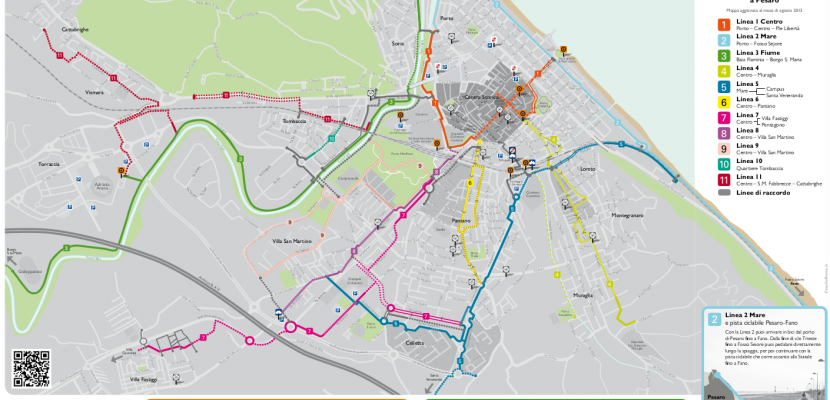Image

BICIPOLITANA Pesaro
Published on 23 July 2018

Italy
Burgenland
This is the good practice's implementation level. It can be national, regional or local.
About this good practice
The “Bicipolitana” concept (Urban cycle paths) has been launched in 2005 with the delivering of the Pesaro City “Plan of the cycle paths” aiming to improve the bicycle circulation in city and to solve conflict between cars and bikes. It has introduced the necessity to plan the cycle lanes in relation to the location of “zones 30” in the urban area. Later, in 2010 the “Plan of the cycle paths” has been updated to complete the already existing cycle paths in relation to the town-planning changes occurred during the last few years in the city.
To the current state, the bicycle routes network of the city has a total extension to approximately 87 km in the year 2017 (in 2010 the network was 55 km). The primary cycling network is constituted by 14 bicycle and pedestrian trails, called “lines”, detectable in radial and tangential routes.
The radial routes link the city center with suburban neighborhoods and are identified by numbers; the tangential routes run in parallel to the coast and are identified by letters.
The secondary cycling network links the nodes of the primary cycling network to the main areas and services of neighborhoods.
The success of Bicipolitana is related to the participation of citizens. Usually the project starts with a comparison activity with traders associations and residents, all in synergy with the neighborhood council. There are also specific councilors’ committees who give opinions on the intervention.
To the current state, the bicycle routes network of the city has a total extension to approximately 87 km in the year 2017 (in 2010 the network was 55 km). The primary cycling network is constituted by 14 bicycle and pedestrian trails, called “lines”, detectable in radial and tangential routes.
The radial routes link the city center with suburban neighborhoods and are identified by numbers; the tangential routes run in parallel to the coast and are identified by letters.
The secondary cycling network links the nodes of the primary cycling network to the main areas and services of neighborhoods.
The success of Bicipolitana is related to the participation of citizens. Usually the project starts with a comparison activity with traders associations and residents, all in synergy with the neighborhood council. There are also specific councilors’ committees who give opinions on the intervention.
Expert opinion
This practice demonstrates a good example of integrating cycle lanes into a city’s transport system, and the scale of the project, and the clear efforts made to communicate it, demonstrate the city’s commitment to cycling as part of a low carbon transport transition. Setting out the cycle lanes in the manner of a metro map is a good way to raise awareness of the cycle network, and provides a very user friendly way for cyclists to plan their use. All in all, it is a sign of the project’s success that cycling has increased by 50% in the city. The practice is highly transferable to other regions.
Works at
Interreg Europe Policy Learning Platform
Resources needed
Cycle network (200 – 400 K€/km) is financed by own municipality's budget, trough private charges related to new urban and construction work, and during street maintenance works optimizing public spaces. Mobility Manager coordinates several departments based on plan integrated with local planning
Evidence of success
By a direct users' survey related to new Bicipolitana's cyclelanes realized between 2012 – 2014 years, emerged: 50% increase of bikers in 2 years in the area of intervention; 73% of respondents use Bicipolitana all year round; usage is related to leisure (41%) and to daily displacements (30%), as for work.
Pesaro is one of the most Bike Friendly City in Italy, with the highest modal share satisfied by bike (about 28%, Report on the Economy of the Bicycle in Italy by Legambiente, May 2017).
Pesaro is one of the most Bike Friendly City in Italy, with the highest modal share satisfied by bike (about 28%, Report on the Economy of the Bicycle in Italy by Legambiente, May 2017).
Potential for learning or transfer
The Bicipolitana has been object of a Study Visit of TRAM Project, held in March 2018, getting good evaluation by european partners regard to the duplicability potential of the experience. Partners reported difficulties similar to the ones of Pesaro; allocation of urban space between different means of transport is recognized as a problem common to all. Partners appreciaded the strategy to have 30 km/h zone surrounded by cycling infrastructures which avoid crossing roads, and to link the main areas of attractions to the secondary networks by way of the bicycle trail. Partners also appreciaded the integration with the new free-flux bike sharing system. Other interesting elements are related to the communication strategy: the visual identity (lines have specific colours that remind a subway) of the lines that they connect various zones of the city affording you a fast displacement with zero expense and pollution, and the promotion of private initiatives like the bike friendly coffee.
Further information
Website
Good practice owner
You can contact the good practice owner below for more detailed information.
Organisation
Pesaro Municipality

Italy
Marche
Contact
Technical Assistance for TRAM INTERREG EUROPE Project
